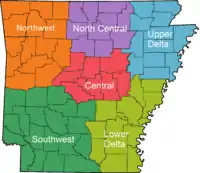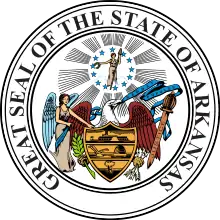List of school districts in Arkansas
This is the list of school districts in Arkansas.[1]
| Part of a series on |
| Regions of Arkansas |
|---|
 |
Background
The proposed school consolidation came as a result of education reform measures spearheaded by the Arkansas Education Association (AEA),[2] which was prompted by a 1921 study done by the Arkansas Legislature that criticized conditions at various public schools.[3]
In the 1926-1927 school year, Arkansas had 4,711 school districts, with 3,106 of them each operating a school for white students that only employed a single teacher. Various laws affecting taxation and state and county governance reduced the number of school districts, including a 1927 law that allowed counties, upon voter approval, to modify boundaries of existing school districts or to create new school districts, Act 156, and a 1929 law that allowed voters in a county to vote in favor of consolidating multiple school districts into one, Act 149.[2] However in 1931 a law was passed stating that in order for a school district to consolidate, the voters in each district must approve.[4]
In the 1932-1933 school year, Arkansas had 3,086 school districts, with 1,990 of them each operating a school for white students that only employed a single teacher. Calvin R. Ledbetter Jr. of the University of Arkansas at Little Rock stated that the Great Depression caused a drop in government revenues and frustrated school consolidation.[2]
In 1946 there were 1,900 school districts educating 406,199 students, with a typical county having an average of 25 school districts. That year 76,000 students lived in a district which had a high school that had not been accredited since there were insufficient students, and about 100,000 students lived in districts that did not operate high schools. Ledbetter stated that about 40% of the K-12 students in Arkansas were realistically not able to go beyond junior high school.[5] That year there was a petition for an Act 1 which would have forced school districts with under 350 students to form "county rural school districts", created as a result of a lack of teachers due to several being drafted into the military, moving out of state, or moving on to defense jobs during World War II.[6] This proposal would mean Arkansas would have about 400 school districts.[5] The two newspapers distributed throughout the entire state of Arkansas supported this.[7] However newspapers did not print advertisements supporting the passage of the act nor did they print the opposite.[8] At the time people advocating for or against political causes bought space to print advertisements for them in newspapers.[9] Voters rejected this with 68,510 opposing (50.47%), with the Arkansas Democrat stating that they were heavily in smaller counties and especially in the state's north, and with 67,209 (49.52%) supporting, credited by the Democrat as being heavily in larger counties. Ledbetter characterized the voting margin as "a fraction".[7]
In 1948 over 60% of Arkansas voters passed Act 1,[8] which was to force any school district with under 300 students to consolidate. No lawsuits resulted from the passage. There were no advertisements supporting the referendum in newspapers,[9] nor any against.[8] Governor of Arkansas Benjamin Travis Laney stated opposition without stating his reasoning.[8] It was favored by Sid McMath, who became the Democratic Party candidate for governor. The two major statewide newspapers also supported this act.[10] Some rural voters were afraid their children would have too long of a commute to school and therefore opposed it.[8]
From 1948 to 1949, the number of school districts fell from 1,600 to 423,[11] and in 1964 this was down to 412.[12] In 1966 there was a referendum to require school districts with under 400 students to consolidate. The Arkansas Gazette supported the measure but Governor of Arkansas Orval Faubus stated opposition to it. Additionally Winthrop Rockefeller and Jim Johnson, two candidates for the 1966 election of the governor of Arkansas, also stated opposition. 321,733 people voted against it, making up 73.59%. 115,452 people voted for it, making up 26.41%. Ledbetter characterized the result as "a landslide".[9]
There were 370 school districts in 1983. After the Arkansas State Board of Education created rules for the minimum level of standards a school district must provide in its educational program that year, the number of school districts declined further,[13] with there being 311 in 1996, and then, as of 1998, 310.[14]
Since 2003, two major components in Arkansas public school districts must exist:
- Each school district must have a high school, and
- Each school district must have 350 students.
The current consolidation policy that mandates operational changes for all districts with fewer than 350 students is the Public Education Reorganization Act—Act 60 of the Second Extraordinary Session of 2003.[15]
Geographical school districts in Arkansas are generally independent from city or county jurisdiction.
Arkansas school district boundaries are not always aligned with county or city boundaries; a district can occupy several counties and cities, while a single city (especially larger ones such as Little Rock, Fort Smith, or Jonesboro) may be split between several districts. Almost all Arkansas school districts use the title "School District", or "Public Schools".
All districts come under the jurisdiction of the Arkansas Department of Education (ADE). Extracurricular activities come under the jurisdiction of the Arkansas Activities Association.
In 1996 the average Arkansas school district had 1,468 students.[14]
Alphabetical Listing by Region and County
Central
Conway County
Faulkner County
Garland County
Lonoke County
Perry County
Prairie County
Pulaski County
Saline County
Lower Delta
Arkansas County
Ashley County
Bradley County
Cleveland County
Desha County
Jefferson County
Monroe County
Phillips County
Single-District Counties
- Lee County School District
- Star City School District (Lincoln County)
North Central
Baxter County
Cleburne County
Independence County
Izard County
Marion County
Searcy County
Sharp County
Van Buren County
Single-District Counties
- Mountain View School District (Stone County)
Northwest
Benton County
Boone County
Carroll County
Crawford County
Franklin County
Logan County
Newton County
Pope County
- Atkins School District
- Dover School District
- Hector School District
- Pottsville School District
- Russellville School District
Washington County
Yell County
Single-District Counties
- Huntsville School District (Madison County)
- Waldron School District (Scott County)
Southwest
Columbia County
Grant County
Hempstead County
Hot Spring County
Howard County
Little River County
Nevada County
Ouachita County
Polk County
Sebastian County
Sevier County
Union County
Single-District Counties
- Hampton School District (Calhoun County)
- Fordyce School District (Dallas County)
- Lafayette County School District
- Mount Ida School District (Montgomery County)
Upper Delta
Craighead County
Crittenden County
Cross County
Greene County
Jackson County
Lawrence County
- Hillcrest School District
- Hoxie School District
- Imboden Charter School District[16]
- Lawrence County School District
- Sloan–Hendrix School District
Mississippi County
Poinsett County
Randolph County
St. Francis County
Woodruff County
See also
References
- Goatcher, Truett (January 1999). "School District Consolidation Will Save Millions of Dollars: Fact of Myth?" (PDF). Arkansas Association of Educational Administrators.
- Ledbetter, Calvin R., Jr. (Spring 2006). "The Fight for School Consolidation in Arkansas, 1946-1948". The Arkansas Historical Quarterly. Arkansas Historical Association. 55 (1): 45–57. doi:10.2307/40028071. JSTOR 40028071.
{{cite journal}}: CS1 maint: multiple names: authors list (link)
Reference notes
- "Search for Public School Districts". Common Core of Data (CCD) 2010–11, National Center for Education Statistics (NCES), U.S. Department of Education (ED). Retrieved 10 November 2012.
- Ledbetter, p. 47.
- Ledbetter, p. 46-47.
- Ledbetter, p. 48.
- Ledbetter, p. 49.
- Ledbetter, p. 48.
- Ledbetter, p. 51.
- Ledbetter, p. 54.
- Ledbetter, p. 46.
- Ledbetter, p. 53.
- Ledbetter, p. 56.
- Goatcher, p. 5 (PDF p. 8/27).
- Goatcher, p. 1/27 (ERIC summary).
- Goatcher, p. 2 (PDF p. 5/27)
- "School Consolidation". The Encyclopedia of Arkansas Culture & History. 26 February 2013. Retrieved 1 March 2013.
- "Imboden Charter District".
Further reading
- Mills, Jonathan M.; McGee, Josh B.; Greene, Jay P. "An Analysis of the Effect of Consolidation on Student Achievement: Evidence from Arkansas" (PDF).
{{cite journal}}: Cite journal requires|journal=(help) - Working paper (authors state "Please Do Not Cite without Author Permission") - "ARKANSAS DEPARTMENT OF EDUCATION RULES GOVERNING CONSOLIDATION AND ANNEXATION OF SCHOOL DISTRICTS" (PDF). State of Arkansas. December 2015.
- "2017 Arkansas Code Title 6 - Education Subtitle 2 - Elementary and Secondary Education Generally Chapter 14 - School Elections § 6-14-122. Consolidation, annexation, or merger of school districts". Justia.
- "School Consolidation". Encyclopedia of Arkansas. Central Arkansas Library System.
